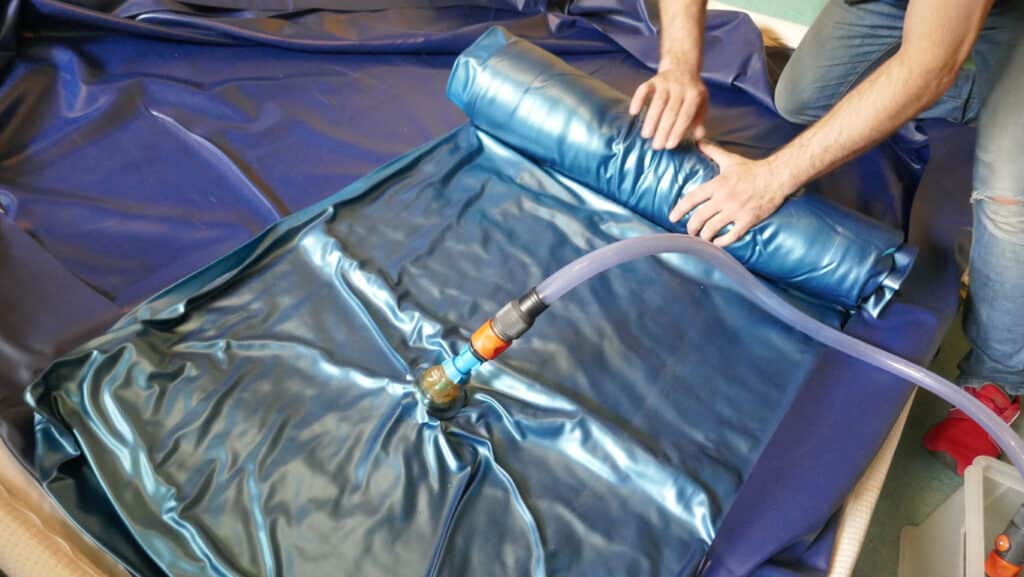Waterbeds have been a staple in many people’s homes for decades. They are known to be comfortable and relaxing, but do they actually help your back?

What is a waterbed?
A waterbed is a bed with water inside the mattress. The water and the mattress work together to create and maintain an equal and comfortable temperature for sleepers.
Why water?
Water actually has many great benefits that can help your back feel at ease while you sleep. It conforms exactly to the shape of your entire body, helping it get rid of the pressure points that could cause pain. It has natural water-based massage properties, which can increase blood flow and circulation, promoting good health for your back.
Difference between a waterbed and a traditional mattress?
The waterbed mattress is not the same as a traditional innerspring or memory foam mattress. The water provides more overall support than just springs, and it can help with back pain because of that. Is a waterbed good for your back? Yes, waterbeds are great for your back because of their supportive properties! Remember some waterbeds can be quite costly, so make sure to shop around for some good deals!
Read also: Can you put a waterbed mattress on a regular bed frame?
Get back pain relief and sleep better with a waterbed
Waterbeds offer more support than traditional mattresses. This is great news if you’re looking to get rid of back pain and sleep better at night! If waterbeds can do that for you, why not give waterbeds a try?
Five Pros of waterbeds for your back
1. Great support
Waterbeds offer uniform support that traditional mattress lack.
Waterbeds can help you sleep better because they conform to the shape of your body and provide a water-based massage.
Sleeping on a waterbed can be quite comfortable. Water beds come in several levels of firmness. If you get one that is just the right level of firmness for your back, then going to bed will be a lot more enjoyable!
A waterbed mattress provides continuous support that traditional mattresses lack, which means it can reduce back pain, and particularly spine pain.
2. Massage
Waterbeds are great for people suffering from back pain because of their massage properties. A water bed has natural water-based massage properties which will help with circulation in the body and offer relief from sore muscles!
3. Soothing heat
Waterbeds can soothe sore muscles through the use of heat as well as the presure relief experienced from the extra support.
4. Suitable for everyone
A water bed is a good choice of mattress for people of all shapes and sizes.
5. Equal pressure distribution
Waterbeds truly conform to the user’s body, resulting in equal pressure distribution of your body weight throughout the mattress. This means there is less pressure on one portion of your back or joints, which is good for spine health. In addition, because waterbeds may be heated, a somewhat heated bed may assist with healthy blood flow in the spine by promoting the transportation of oxygenated blood through the spine.
Cons of waterbeds for your back
Waterbeds can take quite a bit of getting used to, as they feel completely different from a normal mattress.
Not easy to move on
During your sleep, you can’t move around so easily on a water bed, so you may find that you end up waking up feeling stiff if you went to sleep in a less than optimum position.
If you have a condition where you will need to reposition yourself during the night then you should probably avoid buying a waterbed.
More maintenance
Waterbeds require water refilling, water softener and maintenance to keep clean and to prevent the vinyl material from drying out and eventually splitting.
Back pain and full-wave waterbeds.
Waterbed mattresses offer three different movements. They are the full-wave, no wave, and semi-wave actions. Each action provides a specific array of health benefits.
However, the full-wave movement may be detrimental to your back, and even cause back pain or spine pain, because it allows your back to sink low in your bed, causing back misalignments. This effect can stress your vertebrae and joints in your spine.
Are you worried about waterbeds after this revelation? Don’t worry, as you’ll avoid the problems caused by a full-wave action waterbed mattress if you choose mattresses with semi-wave or no wave movements at all.
Are waterbeds expensive?
Waterbeds used to be expensive – typically they were around 3 times the price of a spring mattress on a divan base.
However, in recent years the cost of waterbed mattresses has fallen significantly, and you can now pick up a starter waterbed mattress for as little as $100.
How long does a waterbed last?
Waterbeds can leak water over time, which will degrade the mattress. If you have gone with a lower-quality mattress it’s recommended that you replace your mattress every five years or so
However, high quality waterbeds, which are treated with special water conditioner and well maintained, can last up to 25 years or even longer.
When choosing between water and traditional mattresses, it is important to consider your own pain levels. If you are in a lot of pain when you wake up, waterbeds may not be the best choice for you. However, waterbeds can actually help to reduce back pain, thanks to their consistency and massage properties that are ideal for people suffering from back problems – waterbeds are overall a better choice than traditional mattresses.
Conclusion: Are waterbeds good for your back?
Waterbeds are helpful for those who have back pain, but it is important to remember that waterbed comfort takes a little getting used to. The first few nights you may notice some tossing and turning as your body adjusts. However, once your sleep pattern becomes more regulated waterbeds can be a great addition to any home.
Waterbeds are able to mimic normal sleep positions, making them perfect for those with back pain. However waterbeds will not be beneficial if you don’t maintain water levels.
It is important to keep water levels low enough so the water doesn’t push you up, but high enough so it can support your back.
